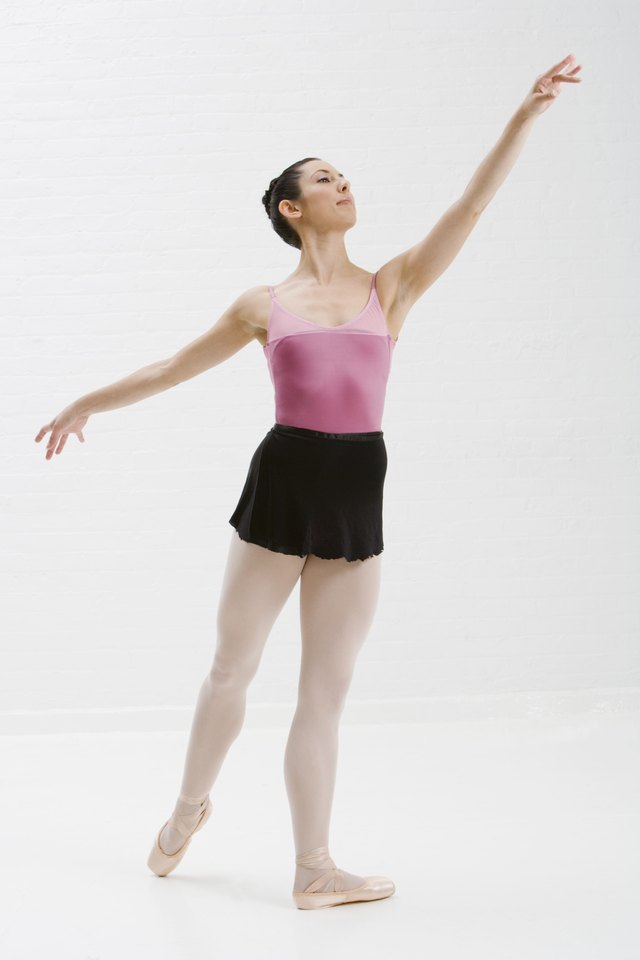What Do Ballerinas Do to Stay in Shape?

Ballet dancers, known for their beauty, artistry, and poise, are also serious athletes. Ballet ranks high on the list of physically demanding activities, and elite dancers need to be in tip-top shape to maintain their rigorous training, rehearsal and performance schedules. Ballet requires cardiovascular endurance, strength, extreme flexibility, speed and agility, all of which boost a dancer’s performance quality and help prevent dance-related injury. To stay in shape, ballerinas often venture outside the dance studio where they engage in cross-training activities that supplement and enhance their regular ballet training.
Cardiovascular Training
Dancers who don't train aerobically can tire prematurely during long, physically challenging pieces. Elizabeth Miner, a dancer with the San Francisco Ballet, started using an elliptical machine when she realized her aerobic capacity was low. Her lack of stamina made it difficult to focus onstage. Other dancers turn to swimming, biking, spinning or brisk walking to boost their cardiovascular strength. Physical therapists who work with dancers often advise against high-impact aerobic activities that put too much pressure on the joints. For this reason, Marika Molnar, director of physical therapy at New York City Ballet, discourages ballerinas from running. She prefers low-impact cardio activities that are easier on the knees, ankles and hips. Low-impact activities are particularly helpful for dancers who want to maintain their heart and lung health while recovering from certain injuries.
Pilates and Resistance Training
Professional dancers were among the first to recognize the benefits of Pilates training. Many ballet dancers now turn to Pilates and other resistance-training activities to build muscular strength. In her book, “The Ballet Companion,” former dancer Eliza Gaynor Minden praises Pilates as particularly beneficial for dancers. She claims it helps dancers build essential core strength, improve alignment, increase flexibility and enhance breathing, all of which contribute to a dancer’s performance quality. In addition to Pilates, many dancers make regular use of exercise bands -- convenient and inexpensive tools for resistance training -- to build strength in their legs, ankles and feet.
Yoga
Ballet dancers keep physically demanding schedules, but they are also subject to intense emotional stress, competitiveness and performance-related pressure. Many dancers find that yoga helps them relax and cope with the demands of ballet, eases muscle tension and promotes proper, more conscientious breathing. At the same time, yoga helps some dancers develop better full-body awareness and often reveals areas where ballet dancers lack flexibility.
Considerations
Although many dance professionals acknowledge that cross-training can improve a dancer’s overall fitness profile, many dancers are concerned that participation in non-dance activities will compromise a ballerina’s aesthetic appearance. According to an article appearing in the 2004 issue of "Sports Medicine," this fear is unfounded. Exercise professionals who are sensitive to the requirements of ballet can help dancers choose exercise and wellness activities that do not diminish their artistry or aesthetics. Dancers should realize, however, that there are risks associated with cross-training. Certain activities -- such as swimming and cycling -- can lead to tightening of the leg and arm muscles, and yoga can lead to overstretching. Both of these outcomes are counterproductive, and elite dancers should take measures to avoid such unfavorable developments.
References
- American Academy of Orthopaedic Surgeons: [Don’t] Break a Leg! Avoid Ballet Injuries
- Pointe Magazine Online: Cross-Training for Technique
- MayoClinic.com: Pilates for Beginners -- Explore the Core of Pilates
- The Ballet Companion; Eliza Gaynor Minden
- Dance Magazine: Your Body
- New York Times: Tips for Ballet Dancers on the Art of Staying Well
- Sports Medicine: The Dancer as a Performing Athlete -- Physiological Considerations
Writer Bio
Judy Fisk has been writing professionally since 2011, specializing in fitness, recreation, culture and the arts. A certified fitness instructor with decades of dance training, she has taught older adults, teens and kids. She has written educational and fundraising material for several non-profit organizations and her work has appeared in numerous major online publications. Fisk holds a Bachelor of Arts in public and international affairs from Princeton University.
